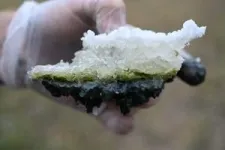(Press-News.org) In wave-making research recently published in Marine and Coastal Fisheries, a team of researchers, led by biologists at the University of Massachusetts Amherst, has quantified the rate at which great hammerhead sharks are eating Atlantic tarpon hooked by anglers at Bahia Honda, Florida—one of the prime tarpon fishing spots in the Florida Keys.
Called the “depredation rate,” the team found that 15.3% of tarpon that were hooked by anglers and fought for more than five minutes were eaten while still on the line. But the researchers also show that this is not necessarily a sign that the ecosystem is out of balance. To the contrary, increased reports of depredation are to be expected, especially as great hammerhead sharks, listed as critically endangered by the International Union for the Conservation of Nature (IUCN), are seeing their population stabilize in the southeastern United States; the result of decades of conservation and management efforts. At the same time, angling is an increasingly popular sport. Which means that there is a greater chance for human-fish-shark encounters. To help manage the health of both the tarpon fishery and the hammerhead population, the researchers urge solutions that don’t impact either species.
Tarpon are one of the most iconic saltwater fish in the Southeastern and Gulf states. Many an angler spends their life dreaming of hooking a tarpon that could easily exceed 100 pounds, which are known to fight fiercely, often leaping entirely clear of the water in their efforts to shake a hook. The tarpon fishery, which extends from Texas to the Carolinas in the U.S., is, by some estimates, a multi-million-dollar-per-year industry, and the fish is tied deeply to local culture.
Yet, despite the legendary toughness of the species, the tarpon is listed as “vulnerable” by the IUCN, and their populations seem to have been affected by fishing, degraded water quality and habitat loss. Recently, guides have been increasingly reporting that sharks are taking a bigger bite out of the tarpon catch in recent years, and may, in fact, pose a risk to the species’ survival. But, until now, there’s been no hard data on just what the depredation rate might be, which makes it difficult to make informed conservation decisions, for either the tarpon or the hammerheads.
To arrive at the depredation rate, and then to track both the tarpons’ and sharks’ yearly movements through a specific area, you need a few things: high-tech acoustic telemetry equipment, stout fishing gear and a comfy lawn chair.
Acoustic telemetry has recently revolutionized scientists’ ability to track migratory marine species. The technique involves anchoring an acoustic receiver in the water and implanting a small transmitter into whatever it is you want to track. In this case, lead author Grace Casselberry, a postdoctoral researcher at UMass Amherst, and her colleagues deployed 16 receivers in a gridded array in the Bahia Honda Channel. They then caught and tagged 51 tarpon and 14 hammerhead sharks. Over the course of more than two years, every time one of the tagged tarpon or hammerheads swam within range of the receiver, the receiver would log that individual animal’s unique ID, date and time.
Then came the lawn chair. “I sat in that chair for two months,” says Casselberry, “watching all day long through binoculars and a camera with a long lens as people fished. Every time someone hooked tarpon, I recorded the time of day, the current, whether the tide was going in or out, which boats were fishing, how many anglers were in the area, how long it took them to bring the tarpon to their boat and whether or not a hammerhead ate the fish. I saw a total of 394 tarpon hooked.”
With all that data, the researchers revealed that the longer the angler fought their tarpon, the more likely it was to be eaten, and that when the fight lasted for more than five minutes, there was a 15.3% chance that the tarpon would be snatched by a hammerhead. These depredations most often occur on an outgoing current, which was also supported by the acoustic telemetry data that showed the hammerheads occupied a smaller area within the channel corresponding to where most tarpon are hooked and fought. The team also found that tarpon tend to congregate in Bahia Honda during the spring, pre-spawning seasons—and the hammerheads know it. So do the anglers.
“Bahia Honda has most likely been a place where sharks and tarpon have congregated for a very long time,” says Andy Danylchuk, senior author and professor of fish conservation at UMass Amherst. “If there was less depredation in recent memory, that is likely due to the fact that the population of great hammerheads was dangerously low.” But fishing pressure has also increased in recent decades. “There are more sharks in the water and also more hooks in the water,” Danylchuk continues, “which is the perfect recipe for more shark-fish-human encounters.” In fact, depredation is a growing issue in the United States, as evidenced by the recent SHARKED Act put before Congress to help find solutions.
Unfortunately, the more anglers and guides see their long-sought fish snatched by sharks, the more likely they are to advocate for culling the sharks.
“It has taken 30 years to get the hammerheads to the point where they are just starting to recover,” says Casselberry, “and all that work could be undone if we start killing sharks indiscriminately.”
“There’s some evidence that the hammerheads are pregnant females,” adds Danylchuk, “and if they are culled, it could decimate their numbers.”
None of this means that anglers need to stop fishing for tarpon in Bahia Honda, but it does mean that conservation efforts, of both tarpon and hammerheads, should be informed by solutions that don’t impact the tarpon, the hammerheads, or the anglers. Casselberry and her colleagues suggest that anglers use fishing gear that will allow them to land tarpon faster, thus reducing fight times and the opportunity for depredation. They should also avoid fishing during the outgoing tide, which is when most depredation events occur. Anglers who use fish-finders should monitor for sharks and consider relocating when hammerheads are in the area.
“We are advocating for anglers to think of themselves as part of the ocean ecosystem, rather than working against it,” says Casselberry.
Photos and video are available in this folder.
Contacts: Grace Casselberry, gcasselberry@umass.edu
Daegan Miller, drmiller@umass.edu
END
Don’t blame the sharks: Research led by UMass Amherst reveals why more hooked tarpon are being eaten
First-of-its-kind research tracks hammerheads, tarpon and anglers, urges ecological solution
2024-01-22
ELSE PRESS RELEASES FROM THIS DATE:
Shallow soda lakes show promise as cradles of life on Earth
2024-01-22
Charles Darwin proposed that life could have emerged in a “warm little pond” with the right cocktail of chemicals and energy. A study from the University of Washington, published this month in Communications Earth & Environment, reports that a shallow “soda lake” in western Canada shows promise for matching those requirements. The findings provide new support that life could have emerged from lakes on the early Earth, roughly 4 billion years ago.
Scientists have known that under ...
Computing with the power of light
2024-01-22
The exponential demand for high computing power is far exceeding the capabilities of current electronic systems; however, engineers at the University of Pittsburgh are shining a light on new solutions.
Nathan Youngblood, principal investigator and assistant professor of electrical and computer engineering at Pitt’s Swanson School of Engineering, received a $552,166 Faculty Early Career Development Award from the National Science Foundation (NSF) and a $449,240 award from the Air Force Office of Scientific Research (AFOSR) through its Young Investigator Program (YIP) to continue his pioneering work in phase-change materials and optical computing.
“Dr. ...
Cholangiocarcinoma: New organ-on-chip aims at accelerating research and personalized medicine
2024-01-22
Milano, January 22nd 2024 – It is only a few centimeters in size and can be held between two fingers, but in the micro-channels carved inside it, it’s hidden a three-dimensional and highly faithful model of a biliary tract cancer called cholangiocarcinoma, complete with its tumor microenvironment. This 3D model is built starting from a sample of patient’s cancer cells and thus it represents a patient-specific "organ-on-chip": a technology made possible only through a multidisciplinary approach that merges biomedicine, physics and engineering.
The innovative prototype is the result ...
Bioengineered material developed to rapidly stop bleeding in patients on blood thinners
2024-01-22
More than 11 million people in the United States take anticoagulation or antiplatelet medications, such as heparin or aspirin, to treat serious conditions like heart attack and stroke. However, these medications also put patients at risk of life-threatening bleeding in the case of injury or during surgery. To improve strategies for reducing blood loss, a team led by investigators from Brigham and Women’s Hospital, a founding member of the Mass General Brigham healthcare system, developed a porous material that maximizes blood absorption and effectively activates clotting mechanisms, even in patients on anticoagulation or ...
New biomarkers for active lupus nephritis discovered
2024-01-22
New biomarkers with improved diagnostic performance for early detection of lupus nephritis have been discovered in the University of Houston lab of Chandra Mohan, a pioneer in lupus research. Early identification of renal involvement in lupus and prompt treatment are essential in reducing the pain, suffering and eventual mortality it causes.
Systemic Lupus Erythematosus (SLE), commonly called lupus, is an autoimmune disease that occurs when the body attacks its own tissues and organs. Inflammation from the disease can impact many different parts of the body including joints, skin, kidneys, blood cells, brain and heart. Lupus nephritis is one ...
New research examines how assumptions affect motion capture technology
2024-01-22
Motion capture technology has applications in a wide range of fields, including entertainment, medicine, and sports, to name a few. But what if the measurements these systems were based on were rooted in social practices and biased assumptions, leading to errors that become ingrained over time?
This question is at the heart of new research co-authored by Mona Sloane, an assistant professor of data science and media studies at the University of Virginia.
Sloane and her co-authors — Abigal Jacobs, an assistant ...
Scientists identify mutations that cause inherited kidney disease
2024-01-22
Genetic changes or mutations can cause hereditary kidney disease, which can eventually lead to dialysis or the need for kidney transplantation. Identifying the cause of inherited kidney disease is the first step in identifying a treatment.
With that goal in mind, researchers at Wake Forest University School of Medicine and the First Faculty of Medicine of Charles University in Prague, Czech Republic, have discovered a new genetic cause of inherited kidney disease.
The findings were recently published in Kidney International.
According to Anthony J. Bleyer, M.D., ...
How the brain responds to reward is linked to socioeconomic background
2024-01-22
MIT neuroscientists have found that the brain’s sensitivity to rewarding experiences — a critical factor in motivation and attention — can be shaped by socioeconomic conditions.
In a study of 12 to 14-year-olds whose socioeconomic status (SES) varied widely, the researchers found that children from lower SES backgrounds showed less sensitivity to reward than those from more affluent backgrounds.
Using functional magnetic resonance imaging (fMRI), the research team measured brain activity as the children played a guessing game in which they earned extra money for each correct ...
New reagent improves the process of making sulfur-containing compounds that may be used in medicines
2024-01-22
During the past decade, there has been significant development of new sulfur containing compounds that are used in various industries, including pharmaceuticals and agricultural products. Sulfoximines, sulfonimidoyl fluorides and sulfonimidamides are types of sulfur-containing chemical compounds that have wide-ranging potential as therapeutic drugs. However, the synthesis process for these compounds is complex and has several limitations. In a new article published in Nature Chemistry, Moffitt Cancer Center researchers describe their ...
New candidate for universal memory is fast, low-power, stable and long-lasting
2024-01-22
We are tasking our computers with processing ever-increasing amounts of data to speed up drug discovery, improve weather and climate predictions, train artificial intelligence, and much more. To keep up with this demand, we need faster, more energy-efficient computer memory than ever before.
Researchers at Stanford have demonstrated that a new material may make phase-change memory—which relies on switching between high and low resistance states to create the ones and zeroes of computer data—an improved option for future AI and data-centric systems. ...
LAST 30 PRESS RELEASES:
Global psychiatry mourns Professor Dan Stein, visionary who transformed mental health science across Africa and beyond
KIST develops eco-friendly palladium recovery technology to safeguard resource security
Statins significantly reduce mortality risk for adults with diabetes, regardless of cardiovascular risk
Brain immune cells may drive more damage in females than males with Alzheimer’s
Evidence-based recommendations empower clinicians to manage epilepsy in pregnancy
Fungus turns bark beetles’ defenses against them
There are new antivirals being tested for herpesviruses. Scientists now know how they work
CDI scientist, colleagues author review of global burden of fungus Candida auris
How does stroke influence speech comprehension?
B cells transiently unlock their plasticity, risking lymphoma development
Advanced AI dodel predicts spoken language outcomes in deaf children after cochlear implants
Multimodal imaging-based cerebral blood flow prediction model development in simulated microgravity
Accelerated streaming subgraph matching framework is faster, more robust, and scalable
Gestational diabetes rose every year in the US since 2016
OHSU researchers find breast cancer drug boosts leukemia treatment
Fear and medical misinformation regarding risk of progression or recurrence among patients with breast cancer
Glucagonlike peptide-1 receptor agonists and asthma risk in adolescents with obesity
Reviving dormant immunity: Millimeter waves reprogram the immunosuppressive microenvironment to potentiate immunotherapy without obvious side effects
Safety decision-making for autonomous vehicles integrating passenger physiological states by fNIRS
Fires could emit more air pollution than previously estimated
A new way to map how cells choose their fate
Numbers in our sights affect how we perceive space
SIMJ announces global collaborative book project in commemoration of its 75th anniversary
Air pollution exposure and birth weight
Obstructive sleep apnea risk and mental health conditions among older adults
How talking slows eye movements behind the wheel
The Ceramic Society of Japan’s Oxoate Ceramics Research Association launches new international book project
Heart-brain connection: international study reveals the role of the vagus nerve in keeping the heart young
Researchers identify Rb1 as a predictive biomarker for a new therapeutic strategy in some breast cancers
Survey reveals ethical gaps slowing AI adoption in pediatric surgery
[Press-News.org] Don’t blame the sharks: Research led by UMass Amherst reveals why more hooked tarpon are being eatenFirst-of-its-kind research tracks hammerheads, tarpon and anglers, urges ecological solution





